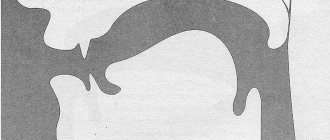1. Pronunciation of the sound [S] 2. The difference between the articulation of the sound [Z] and the sound [S] 3. Articulation of the sound [C] 4. Methods of setting the sounds [S], [Z], [C] step by step 4.1. Lip exercises 4.2. Gymnastics for the tongue 4.3. Breathing exercises 5. Second stage of production 6. Automation of sounds [S], [Z], [C]. Working with cards.
Work to eliminate the shortcomings of pronouncing the sounds [С], [З], [Ц] in most cases requires lengthy and painstaking actions. The teacher needs to clearly imagine the correct articulation of these sounds.
Correct articulation of the sound Z
The sound “Z” is a sonorous whistling sound; the formation of the organs of the speech apparatus is important for its pronunciation. The articulation of sibilants depends on the position of the tongue in the oral cavity and the shape that the tongue takes during speaking.
A speech therapist will always help you find the cause of incorrect pronunciation.
Features of articulation “Z”:
- The lips are stretched into a smile, the mouth is slightly open, teeth are visible.
- The jaw is not closed, there is a gap between the teeth.
- The wide tip of the tongue rests firmly on the lower front teeth.
- The lateral edges of the tongue are pressed against the molars, forming a hollow in the middle.
- A narrow gap is formed between the upper palate and the center of the tongue, through which an air stream passes.
- The soft palate is raised and pressed against the back wall of the pharynx, thereby closing the passage into the nasal cavity. Air passes through the mouth when speaking.
- The vocal cords tense and vibrate to produce the voice. When the voice is added, the exhaled air turns into a ringing sound “Z”.
Problems with the articulation of “Z” arise if the child has a flat tongue, it is difficult to form a hollow, and there are difficulties in speech breathing. Hissing defects spoil a child’s speech and require professional correction.
The baby does not pronounce whistling sounds, when should we start combating this phenomenon?
If you wait until the age of five to take your child to a speech therapist, you may be late, the child will develop incorrect pronunciation, and it will be increasingly difficult for him to change anything. It doesn't take an expert to understand that babies need to create a trigger to begin pronouncing sounds correctly. And it’s better to do this at 4 years old. Many parents cope with their child’s speech defects themselves, without the participation of speech therapists.
If the baby does not have serious speech disorders, then producing whistling sounds will not be difficult. All you have to do is follow the recommendations of this article so that your child will soon delight you with a ringing Z and other correctly placed sounds. Once this skill has been achieved once, your task will be to consolidate the skill, that is, to bring it to the level of automaticity.
If your baby’s sounds are impaired, he speaks incomprehensibly, or only you can understand it, you cannot ignore a speech therapist. It would be impossible to do without his participation. The earlier you come to your first conversation with a speech therapist, the faster the results will be achieved and consolidated.
All the following exercises will be useful not only for kids, but also for school-age children, and even for parents themselves, since articulatory gymnastics at any age develops the speech apparatus, makes it more pliable, flexible, teaches how to control it perfectly, and how to control it according to at your own discretion.
Step-by-step work is the most important thing in the fight against poor pronunciation. How to competently approach the issue of setting sounds and what you need to understand for yourself:
- Awareness and understanding of all movements of the organs of the speech apparatus that are needed to pronounce a certain sound.
- The emergence of the correct sound.
- Consolidating the given sound in the child’s spoken speech, both in individual syllables and in entire phrases and rhymes.
Types of incorrect articulation
Violations in the pronunciation of “Z” can be divided into 2 groups:
- expressed in distorted pronunciation of whistling sounds (sigmatism);
- expressed in replacement with other sounds (parasigmatisms).
Types of sigmatism:
- Interdental. The tip of the tongue is located between the teeth. Speech acquires a “lisp.”
- Side. The lateral edge of the tongue is pressed to the right or left to the molars. The tongue rolls to one side.
- Nasal. When speaking, air enters the nasal cavity. Nasal sigmatism occurs in children with cleft palate or palate paralysis.
Types of parasigmatism:
- Prizubny. When pronouncing the sound “Z”, the tongue rests on the closed teeth. Because of this, “Z” is replaced by “D”.
- Hissing. During pronunciation, the lips are strongly rounded and no groove is formed on the tongue. "Z" changes to a soft "F".
- Emollient. The mouth does not open enough, the teeth do not come apart from each other. The result is a sound that is softer than required.
- Replacements due to deafness. The lips are drawn out into a long tube, the tongue does not rest on the teeth, and there is no sonorous sound.
If defects in sound pronunciation are not corrected, then during school years the child will develop illiterate oral and written speech and will have problems with reading and understanding what is read.
In addition, problems with sound pronunciation can arise as a result of damage to the speech parts of the brain.
If a child has a correctly formed articulatory apparatus, but the sound is still not produced, it is worth seeking advice from a neuropsychologist. He will conduct a diagnosis and draw up a correction plan.
Preparatory exercises
Speech therapy correction work begins with the preparatory stage, which includes:
- preparing children for classes;
- exercises to train the articulatory apparatus;
- study of speech organs;
- familiarization with self-massage techniques;
- exercises to develop the muscles of the neck and shoulders;
- development of fine motor skills.
The lesson begins by inviting the child to play; you can tell him fairy tales about the Tongue. If you get your child interested, he will perform the exercises more actively, which means he will achieve a positive result faster.
Preparatory complex:
Children are more willing to do exercises with edible straws.
- Self-massage. The fingertips stroke the facial muscles in the direction of:
- from the middle of the forehead to the temples;
- around eyes;
- from the bridge of the nose to the ears;
- along the back of the nose up and back.
- Vibration massage. Tapping the wings of the nose while pronouncing the sound “M”.
- Studying parts of the speech apparatus in front of a mirror. Together with the child, name the speech organs and consider their location.
- Games for stretching and relaxing the muscles of the shoulder girdle: “Stretch”, “Cat”.
- Lacing games according to the Montessori system for training fingers and developing fine motor skills.
Let's start with an articulatory warm-up!
A child who mispronounces one of the whistles will probably mispronounce the rest of them, by analogy with the first one. The most common reason for the incorrect pronunciation of these sounds is the inflexibility of the organs that are involved in its reproduction. This is why regular exercise is so important. Mobility is not achieved with one lesson, but is developed with each new lesson. There should be no breaks in daily exercise.
The best time is morning. To conduct the lesson you only need three minutes of time before breakfast. Always teach your children in the form of games. To conduct articulation warm-ups you need to know several rules:
- Perform no more than 2-3 exercises at a time, but each exercise is repeated many times.
- Do not introduce more than one new exercise at a time; if there are difficulties with the old exercises, it is forbidden to include a new one in the process until the old one has been worked out.
- A mirror is the best assistant when working on correct articulation. All your movements and the work of the baby’s speech apparatus should be visible to the child, so that he has the opportunity to compare what he sees in you and in himself.
- Not just any exercise – there is gymnastics! If you came to training and lazily waved your arms, you will never be successful. It’s the same when working with pronunciation: all exercises must be done well.
- Do not scold your child for those moments when he does not succeed, especially do not be upset yourself. Everything requires skill. Praise your child for any correctly performed movement.
Setting the sound
Speech therapy work on sound production is carried out in 5 areas:
- By imitation. To do this, the child must have developed phonemic hearing.
- Using a mechanical method. If the child cannot independently shape the tongue or make vibrating movements, then the speech therapist helps with special tools (spatula, spatula). To minimize the use of instruments, much attention is paid to articulatory gymnastics in classes.
- Based on formed sounds. “Z” is well placed on the basis of the related “S”. If “C” is also not sufficiently worked out, then they put “C” from “T”. Gradually, the child reproduces “Z” by adding his voice.
- Staging from articulation exercises. To pronounce sibilants, the tongue performs complex movements, using the tip of the tongue, its back and lateral edges. The lips and jaw should also be active when speaking. To practice precise movements of the speech organs, articulatory gymnastics are performed.
- Mixed method. An individual correction plan is drawn up, which includes the listed methods.
By imitation
Setting phonemes by imitation requires the teacher to have competent speech and correct sound pronunciation, because children copy the articulation of adults. To stage “Z,” you can invite preschoolers to play the game “Mosquitoes.”
The teacher asks the children to remember how mosquitoes buzz and ring in the summer. Children are divided into 2 categories: “mosquitoes” and “tourists”. Hoops are placed on the floor. The task of the “mosquitoes”: to catch the “tourists”, the task of the “tourists”: to run from the “mosquitoes” into a hoop. Children who pretend to be mosquitoes utter a loud, drawn-out “ZZZZZZZ.” After a few minutes, the participants switch roles.
After the game, the teacher pays attention to the sound of “Z”, sonority and volume. It is necessary to monitor the completion of the task for each child and check the correct position of the speech organs.
Mechanical method
If a child cannot independently put his lips and jaw in the desired position, a specialist will help him with this. He:
- asks the child to smile,
- and at the same time holds his lower and upper lips with a clean finger or spoon,
- in this position, the child pronounces a long sound “Z”,
- As soon as a clear sound is obtained, the finger is removed.
The exercise is repeated until the sound is heard. It is important to teach the child to involuntarily lower and raise his lips.
Staging from reference sounds
Specialists begin working with whistling people with the sound “S”, from which they later add “Z” and “C”.
The difference between “Z” and “S” is that when pronouncing a voiced “Z”, the vocal cords close and vibrate, the pressure of exhaled air becomes weaker, and the gap between the tongue and the alveoli is narrower. The air stream is less intense than when pronouncing “C”.
The speech therapist asks the child to say “SSS” and then add voices to the sound. The presence of a voice can be controlled by hearing, as well as by tactile sensations by placing a hand on the neck.
Staging from articulation exercises
Exercises for articulating the sound “Z”:
- "Gorochka". The teacher and the child remember what a mountain looks like and depict its shape with their hands. Afterwards, the child is asked to create a mound with his tongue, lifting its middle.
- "Breeze". The child stretches out his lips with a tube and blows, after which the teacher lifts his upper lip and asks him to blow again.
- "Lock". Teeth closed, lips parted. The speech therapist explains that the tongue is behind the fence and cannot be released. The child presses his tongue against his teeth several times.
- "Climber". The tip of the tongue rests on the lower incisors, the back of the tongue arches. The child is explained that the lower jaw is part of the rock on which the tongue needs to rest. The movement of the tongue is monitored using a mirror and the number of seconds it is possible to hold in this position is noted.
- "Stream." The mouth is slightly open, the teeth are not completely closed, so as to form a gap. The child is invited to play with the stream: release a stream of air through the resulting crack.
- "Coil". The tip of the tongue is pressed from the inside to the lower incisors. The middle part of the tongue bends strongly, forming a hollow in the center. The tongue rolls out of the mouth and hides back. An important condition: do not tear the tip of your tongue from your teeth.
- "Naughty tongue." The mouth is open, the tongue is relaxed, lying in the middle of the lower lip. The child slaps his tongue with his lips without touching it with his teeth.
Articulation complex exercises
At home or in kindergarten, but it is better to start with the following set of exercises:
- We make a long tube with our lips, try to pull it out as far as possible, and hold it for as long as possible. We make sure that only one lips are working.
- We stretch our mouth into a smile. With this exercise, the teeth are clearly visible and the lips are stretched as much as possible. We keep smiling until our lips become tired.
- We make a ring from the lips and again hold them in this tense state.
- We alternate this chain: tube - ring - smile - tube - ring - smile and so on.
- In the smile position, open and close your mouth. It is important that the lips do not make any extraneous movements.
- We stick our tongue out of the slightly open mouth and ensure that the tongue becomes flat.
- The same exercise, but we achieve a sharp and narrow shape of the tongue.
- We combine the previous two exercises and force the tongue to alternately take a wide and narrow shape. We alternate actions.
- Raise your tongue and hide it behind your upper teeth.
- We alternately raise the tongue to the upper palate and lower it to the lower palate. We repeat many times.
- Press the tip of the tongue against the lower palate near the teeth and make the tongue “stagger”, either going deeper into the mouth or approaching the teeth.
We check if the baby easily performs articulatory exercises, then move on to sound production complexes. And if the baby has a very difficult time performing these movements, then we only train them for now before learning the sounds.
Sound automation
The stage of sound automation is the consolidation of reflex connections on speech material.
Automating sound means introducing it into syllables, words, phrases, coherent speech according to the principle from simple to complex.
Automation of a given sound begins when the child correctly pronounces it in isolation and repeats it many times.
Sound automation work is carried out within 10 minutes. The work is carried out 2 times a week in specialized classes and every day at home with parents. During the lesson, first of all, the child’s successes are noted, gently correcting mistakes.
The sound “Z” is practiced in stages:
- In syllables (direct, reverse, with a combination of consonants). Children repeat after the teacher the sound combinations ZA-ZA, ZU-ZU, ZE-ZE, ZO-ZO, ZI-ZI.
- In words (at the beginning of the word, middle, end). Automation in words is first carried out based on syllables (zu - tooth), then in words with a combination of consonants. Words are selected from monosyllabic to polysyllabic gradually.
- In riddles and tongue twisters: a-za-za, za-za-za. A goat is chasing after Zina. Zu-zu-zu, zu-zu-zu. Let's put the goat in the pen. Zy-zy-zy, zy-zy-zy. Goat's bell. Ze-ze-ze, ze-ze-ze. We will give the hay to the goat.
- In stories. Children make up short and long stories with words that contain the letter “Z”.
- In colloquial speech. Practicing sound in spontaneous everyday speech, control over pronunciation by adults. Simultaneously with the development of the phonemic aspect of speech, the vocabulary is enriched and the grammatical structure of speech is formed.
You can automate the sound “Z” using a series of pictures:
- choose from the proposed drawn objects those that have the sound “Z”;
- divide the pictures into groups with “Z” at the beginning of the word, in the middle and at the end;
- separate pictures with sounds “S” and “Z”.
A set of exercises for clear pronunciation of the sounds C, Z, S
Before performing the exercise, tell your child in words how the tongue should move, and watch how the baby performs them. Kids won't be upset by the mistakes they make if you treat them with humor. A common mistake can be puffing out your cheeks. Let the baby hold his cheeks with his hands so that they do not puff up.
Goal!
The first important skill when producing the C sound is to learn how to reproduce a long, continuous stream of air. Place two elements of the construction set or cube on the table - these will be the gates. Place a cotton ball in front of them. The baby must stretch out his lips, fold them into a tube and use a stream of air to push the ball into the goal. Cheeks should not puff up! The air supply occurs not through the cheeks, but from the lungs.
The tongue lay down to rest
We open our mouth slightly and, with the help of lightly patting our lips, say “five five five five.” Now we show a relaxed, flat, wide tongue from the mouth and place it on the upper lip. We do “five five five five” directly along the back of the tongue - this is a massage for the resting tongue. Each pat of the tongue with the lips should be done with one exhalation.
Pancake tongue
Teach your child to hold his tongue in a relaxed position and stick out for as long as possible. It is important that your lips should not tense or curl up. The sides of the tongue should touch the corners of the mouth - a wide tongue.
Clean teeth
Use the tip of your tongue to “clean” all the teeth in your mouth. Pay attention to both the “backs” of the cloves and their outer surface. This exercise is especially important when it is necessary to produce the sound C. Make sure that your lips are motionless during the exercise and stretched in a calm smile.
Differentiation from consonant sounds
Preschoolers have problems distinguishing paired sounds. They often change “Z” to “S”. To solve this problem, the teacher offers differentiation games.
Work on differentiation of sounds is carried out in the following directions:
- development of auditory differentiation;
- consolidation of pronunciation differentiation;
- formation of phonemic analysis and synthesis.
First, the speech therapist asks you to feel the difference in pronunciation using your hand, which is located on your neck.
It is important for children to remember that with “Z” the throat vibrates.
Then children place an open palm in front of their mouth and feel the difference in the air stream that comes out when pronouncing similar sounds.
At the next stage, work is carried out with speech material with mixed sounds. Exercises are carried out to divide words into groups with different letters, gymnastic games with clapping and other movements.
How to set sound mechanically
Speech development can also be carried out mechanically. In this situation, it is recommended to actively use special simple exercises:
- “Depict” a wide smile on your face, with your tongue in an interdental position. An important condition is not to touch the upper row of teeth. After some time, the mouth muscles relax, then the exercise is repeated again.
- The next step is to blow on the tip of the tongue, which should be protruding from the oral cavity. To feel the air stream, you should place your palm to your lips.
- While the child is blowing air, you need to press on the tongue with a toothpick. This will help form a groove through which the air stream is directed.
- At the next stage, the jaws close, but the toothpick remains between them. It helps fix the tongue in the desired position. The passage of an air stream will cause a whistle.
- While playing the whistling sound, you need to press a toothpick on different parts of the tongue, identifying in which position the “s” will sound correctly.
- After the child manages to pronounce the desired sound, the exercise is performed without using a toothpick.
Automation in spontaneous speech
Consolidating the sound “Z” in spontaneous speech includes adult control over the child’s pronunciation.
It is important to monitor correctness and immediately correct defects so that the child does not develop stereotypes.
You can return to each stage of sound production if necessary, and play games for reinforcement and automation.
Adult speech is the main tool for fixing sounds in a child’s phonemic structure. By surrounding children with literate speech, adults create an atmosphere for the correct development of their sound pronunciation.
Ts – cheerful sound and friend!
The sound C is related in articulation to Z and S. And the sound C consists of two sounds - T and S. Therefore, when pronouncing it, we must teach the child to correctly reproduce both of these sounds at the beginning.
When pronouncing C, the air wave is quite strong. Usually C is given to children simply, since it is based on the pronunciation of previously learned C. You can automate the sound using special verses, which a specialist will suggest to you.
Working on making sounds for babies is an exciting and fun process. Do not try to teach the child, it is better to play with him, then the result will be much more productive.
Video with articulatory gymnastics for clear pronunciation of whistling sounds (s, z, z):










